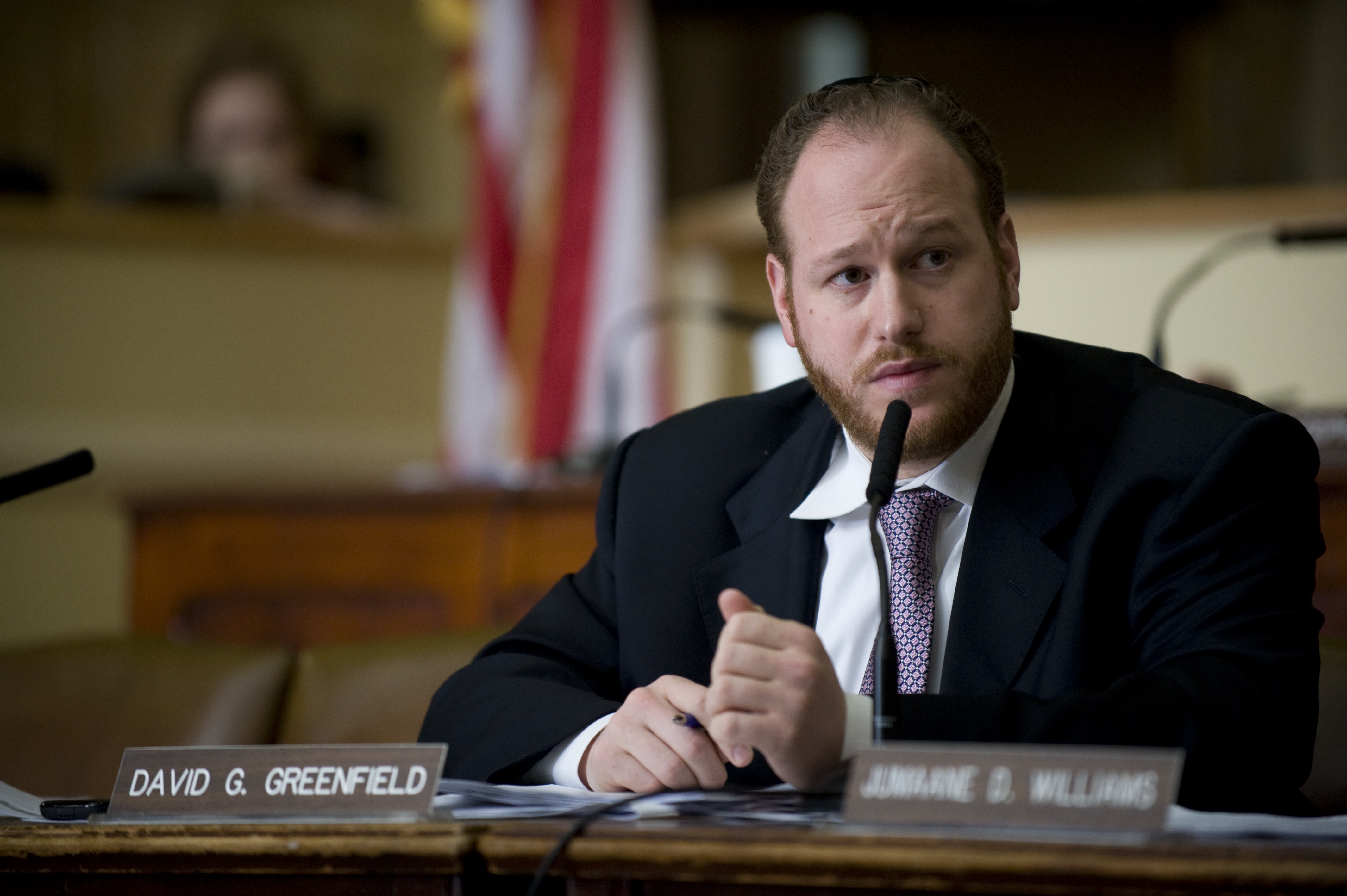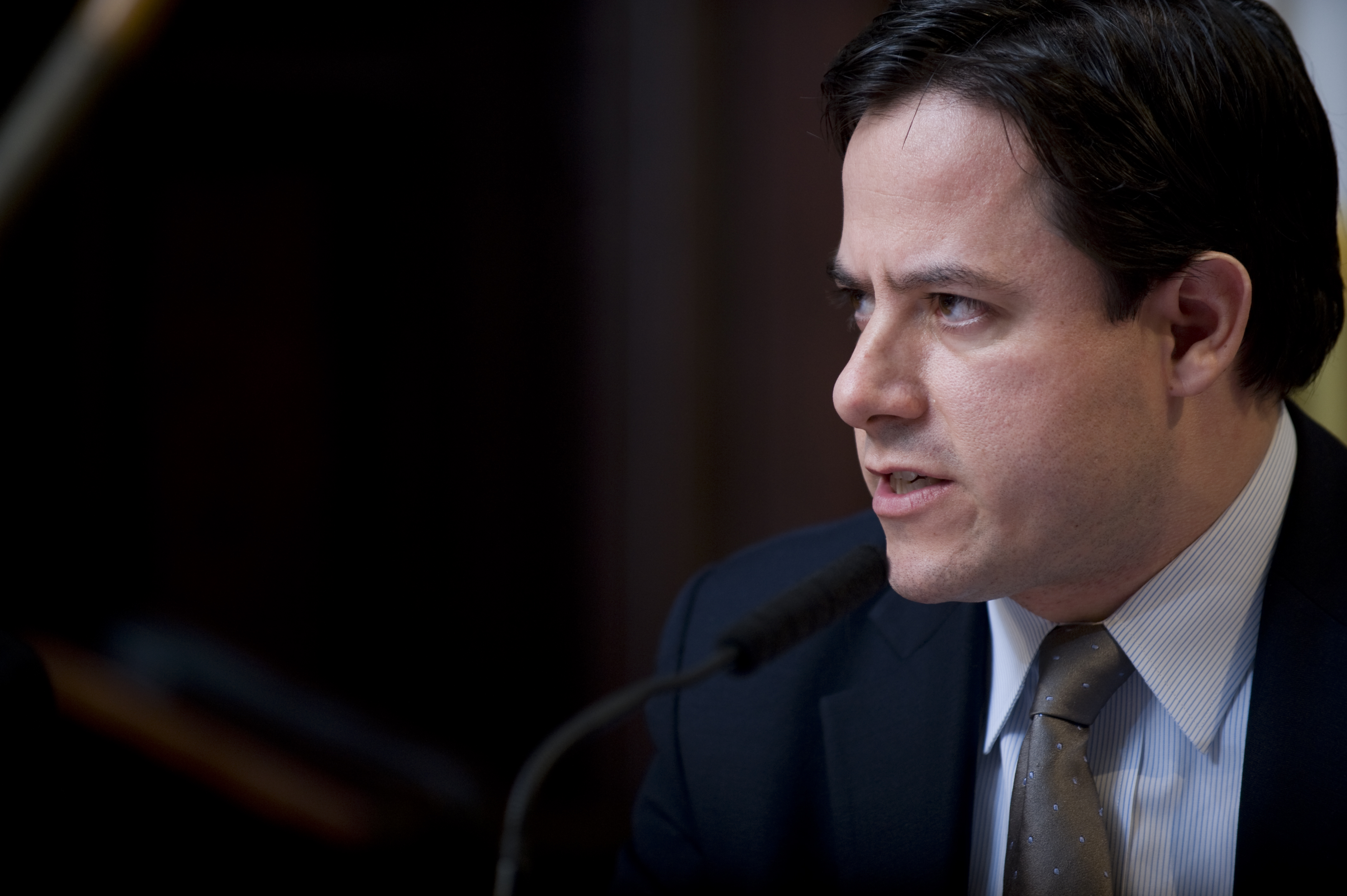

Councilmember David Greenfield, chair of the Committee on Land Use, co-sponsored one of the Landmarks Law bills . Image credit: William Alatriste/New York City Council
Landmarks Chair testified that changes could be better promulgated through agency rule-making rather than by legislative fiat. On September 9, 2015 the City Council held a hearing on two potential bills that would alter the Landmarks Law section of the Administrative Code. The hearing drew a crowd that filled the main Council chamber, with over 100 people filling out forms to testify on the proposals.
The bulk of the controversy surrounded Introduction 775 sponsored by Council Member David G. Greenfield, Land Use Committee Chair and Council Member Peter Koo, chair of the Subcommittee on Landmarks Public Siting and Maritime Uses. The legislation would establish maximum timelines for the designation process, mandating that a hearing on a potential historic district take place within one year of calendaring, and that the vote on designation take place within one year of the public hearing. For individual landmarks, scenic landmarks, and interior landmarks, Landmarks would have 180 days to hold a public hearing after calendaring, and 180 day after the hearing to hold a vote on designation. For historic districts and other landmarks, if the Commission failed to hold a vote within the required time frames, the item could not be calendared again until at least five years had passed.
Greenfield criticized the “indefinite decision-making” process of Landmarks which has led to the backlog of 95 items that have been calendared but not ultimately disposed of, some of which have been on Landmarks calendar since the 1960s. He characterized the legislation as a “good government” reform, and noted that the timeframes Intro. 775 would establish were longer than those for designation in other American cities with historic district protections, such as Miami and San Francisco. Koo said the Landmarks Law needed the reforms to make it more clear and predictable for the average New Yorker.
The hearing also included an associated bill amending the Landmarks Law, Introduction 837, sponsored by Land Use Committee member Council Member Daniel Garodnick. Intro. 837 would require that Landmarks post on its Web site all requests for evaluation that the Commission received, as well as properties surveyed by Landmarks staff, and the status of consideration of those properties, and associated documents.
Landmarks Chair Meenakshi Srinivasan testified before the committee and answered questions from Council Members. Srinivasan stated that both bills, as drafted, could potentially “undermine the Landmarks Law and the agency’s ability to work efficiently.” While the underlying goals of both pieces of legislation were worthy good government practices, she argued that “changes in these areas are most appropriately accomplished through the agency rulemaking process and internal policies.” She said the timeframes proposed for the decision-making process on historic districts were too short, arguing that three years were sometime necessary for the required research and outreach given agency resources. Srinivasan noted that districts varied widely in size, and that more time would allow for a “fair, transparent and, if necessary, iterative process.” Srinivasan stated she was committed to moving items through the designation process “efficiently and fairly,” and was not averse to the institution of “reasonable timeframes.” However, she asked that the length of time be extended to three years for the district designation process.
Srinivasan strongly opposed the five-year moratorium, saying “we believe that there is no public policy objective served by curtailing the Commission’s ability to rehear an item that is meritorious.” She envisioned several impediments that could prevent a timely decision that had no relationship to an item’s merit as a landmark, including a lack of political support or opposition within the community.
Srinivasan expressed concern regarding the second bill, Intro 837. She explained that the Commission formally begins consideration of a property only when it is calendared at a public meeting. She stated that “an RFE is a request by the public to evaluate a building or district to determine eligibility for possible designation…not an application, nor the first step in the designation process.” As proposed, the bill would identify RFEs as “items under consideration,” Srinivasan said the “the bill manifests a “misunderstanding of the commission’s process,” and “would not enhance transparency but, rather, convey misinformation to the public.”
She added that the bill would strain agency resources, given that Landmarks receives approximately 200 RFEs and surveys over 2,000 properties every year. Srinivasan saw “little justification for expending scarce agency resources on compiling, uploading and maintaining updated information about properties…not under active consideration.” She promised to add calendared items to the publicly accessible CityMap database, to increase transparency regarding items under consideration.
Council Member Greenfield said he would be willing to shorten the length of the proposed moratorium, and to create provisions where Landmarks could extend the designation timeframe in instances of extenuating circumstances, revising the bill in consultation with Landmarks to find a “middle road.”

Councilmember Dan Garodnick, sponsor of the second Landmarks Law amendment bill. Image credit: William Alatriste / New York City Council
Council Member Garodnick proposed revising Intro. 837 so that only RFEs submitted by community boards would fall under the requirements. Srinivasan still believed the legislation could potentially mislead the public, conflating the evaluation process with the designation process.
Committee Members Council Member Helen Rosenthal and Council Member Rosie Mendez opposed the bills as currently written, with Mendez saying their requirements would be “too restrictive,” and Rosenthal speaking in favor of a “budget solution” that would allow Landmarks to more efficiently accomplish its work. Council Member Margaret Chin stated that the legislation could have the unintended effect of occupying a significant chunk of Landmarks’ resources to ensure compliance. Council Member Inez Dickens said she had originally supported the bill, but had come to realize that some beloved landmarks in her Harlem district would not have been designated within the proposed time frames. Council Member Ben Kallos strenuously opposed Intro 775, which he said would undermine the landmarking process and unfairly punish communities for inaction by Landmarks. Council Member Jumaane Williams supported reform of the Landmarks Law, saying that when he served on the Landmarks subcommittee he often found the issues mystifyingly “arcane.”
A panel of elected officials who wished to comment on the bills included Manhattan Borough President Gale Brewer, Brooklyn Assembly Member Jo Anne Simon, and a representative of Manhattan Assembly Member Deborah Glick. Brewer said the Landmark Law could be improved, but expressed concern that the bills could have the unintended effect of weakening the Landmarks. Brewer favored passage of Intro. 837. Glick and Simon both opined that the laws would hinder the goal of historic preservation in the City.
Speakers who opposed the bills, or wished to see them modified, constituted the majority at the hearing that stretched to over five hours, included former Landmarks Chair Gene Norman, now of consulting firm Architecture Plus. Norman testified that landmarks “require time and skill” to record their attributes, history and cultural importance, and said Intro. 775 would “lessen the number of future landmarks due to deadlines being missed or owners using delaying tactics.”
Christy MacLear of the Municipal Art Society expressed concern about many aspects of the bills, and strongly advised the removal of the five-year moratorium on reconsiderations in particular. The Greenwich Village Society for Historic Preservation’s Andrew Berman noted that Intro. 775 provided no additional resources to Landmarks to comply with its mandates, and would encourage “obstruction and delay by resistant developers.” Historic Districts Council President Dan Allen noted that Landmarks was one of the “smallest and least-funded agencies in City government,” and “artificial time limits imposed on an already overworked agency would be disastrous.” The New York Landmarks Conservancy’s Andrea Goldwyn posited that the deadlines “may result in an equity problem in what the Commission chooses to pursue,” and that the proposed moratorium could serve to prevent Landmarks from fulfilling one of its “core missions.”
Speakers who testified in support of the bill included the Real Estate Board of New York’s Michael Slattery, who said Intro. 775 would be helpful to home and business owners by bringing “greater predictability” into the process, and “good public policy.” A representative of the Partnership for New York City called the current state of the landmark process “a highly political process that can leave building owners in limbo for years,” and urged swift approval of Intro. 775, saying it would offer “greater certainty to developers,” and “prime the area for the investment and modern redevelopment.” Representatives of the Buildings and Construction Trades Council of Greater New York, the Downtown Brooklyn Partnership, SEIU 32BJ, the Manhattan Chamber of Commerce, the Rent Stabilization Association, and the New York State Association for Affordable Housing, also testified in favor the proposed bills.
At the hearing’s conclusion, Council Member Greenfield, thanked all the speakers, and vowed to take their comments into consideration in revising the bills. He did not establish any dates for further action.
Council: Introductions 775 (2015), 837 (2015) (Sept. 9, 2015).
By: Jesse Denno (Jesse is a full-time staff writer at the Center for NYC Law)
